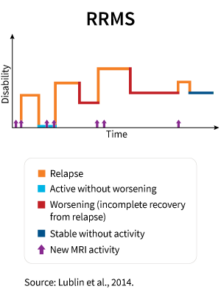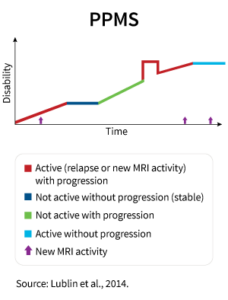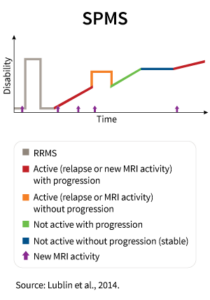Last week I discussed the causes of multiple sclerosis and there were many. This week I’m going to cover the types of multiple sclerosis and there are not nearly as many to go over in this category. Overall, the disease itself is the same. It is an autoimmune condition where your body attacks the myelin that coats the neurons, which creates the disability. What is different in each of the five types, is the severity of the progression and disability. Let’s dive in and take a look at each of the five.
Clinically isolated syndrome or CIS is the first episode of symptoms that someone experiences that is caused by inflammation and demyelination of either the brain or spinal cord. This has the same criteria of a relapse, needs to last for at least 24 hours, but is missing some other diagnostic criteria of MS. Individuals who are diagnosed with CIS, have a higher chance of being diagnosed with MS later in life but won’t always be diagnosed. As imaging and testing improves, I can imagine that the diagnosis of CIS will become rare. If there is evidence of prior activity, then the diagnosis of CIS would not apply.
Relapsing remitting MS type is the most common form of MS. This is when individual has two distinct periods, disease progression and disease remission. During disease progression, an individual would have a relapse and subsequent symptoms, then the symptoms will eventually fade and they will return to their baseline state. The two periods are very clearly defined and switch back-and-forth as the years go on. During the remission phase, all symptoms may disappear or some may linger and become permanent.

Primary progressive MS type is defined by the persistent worsening of function from the beginning of experiencing symptoms, without experiencing the relapses or remissions. This form will progress steadily from the time of onset. Individuals will experience worsening of their symptoms at varying rates but the progression will be constant. At times the progression my reach a plateau as well, then will pick up again.

Secondary progressive MS type initially starts out as relapsing remitting then will begin to follow a progressive course. Many people who start out with relapsing remitting will eventually transition to secondary progressive. At one point in time it was thought that after about 10 years of having relapsing remitting you would progress into secondary progressive. However, this data was taken before the widespread use of medications. I actually just recently asked my own neurologist about this statistic, as I just reached my eight year anniversary. He was very adamant that this was not the case anymore due to having such a wide array of medications that are available for so many people. This was very encouraging to me! He also stated that due to my lifestyle factors, diet and exercise, I’m also doing myself a world of good at preventing any further progression.

Progressive relapsing MS is exactly what it sounds like. There is a steady worsening of symptoms over the years with periods of acute exacerbation’s. This is a very rare type, thank God, but still one to be aware of. About 5% of individuals with MS have this type. Sometimes all of the progressive types of MS are lumped together and called “Chronic progressive MS”.
If you like what you’re reading, consider joining the LissMS Community! I share bi-monthly extras, like recipes, deals and more!
Image source: https://www.nationalmssociety.org/What-is-MS/Types-of-MS

I’M ALISSA!
I help women who have also been diagnosed with Multiple Sclerosis make specific and personalized diet, lifestyle & subconscious changes so that they can begin to heal their body, reduce disease symptoms, and return to a life they love.hey there,
Previous Post
Sleep and the Autoimmune Protocol, Part 2Next Post
Relapses, Exacerbation’s and Flaresfollow along on Instagram:
It’s been a week for me… maybe you too?
Use this short video for a moment of peace and regulation.
What do you notice in your body and about your emotions when you exhale and drop your shoulders?
Or when you hear bird songs?
Notice what makes you feel more calm, relaxed and at peace.
Do more of that..

It’s been a week for me… maybe you too?
Use this short video for a moment of peace and regulation.
What do you notice in your body and about your emotions when you exhale and drop your shoulders?
Or when you hear bird songs?
Notice what makes you feel more calm, relaxed and at peace.
Do more of that.. ...
I get it… I was once in paralysis by analysis for years!!
I’m creating a Masterclass/Workshop experience in August to cover this exact topic: what and how to eat for MS.
BUT!! I need your help to narrow down what we’ll be talking about.
Which of these options sounds most helpful?
Comment the number below!!
Workshop ideas:
1. Simple Nutrition for MS: what you need to know about eating for healing
2. Create Your Own MS Diet: How to know what is best for YOU, while also helping MS symptoms
3. Education into Action: How to put the knowledge you have into action steps that make progress
4. Blend of it All: Education, steps to finding your own MS diet and how to get started
Want something else?? Tell me 👇🏼👇🏼

I get it… I was once in paralysis by analysis for years!!
I’m creating a Masterclass/Workshop experience in August to cover this exact topic: what and how to eat for MS.
BUT!! I need your help to narrow down what we’ll be talking about.
Which of these options sounds most helpful?
Comment the number below!!
Workshop ideas:
1. Simple Nutrition for MS: what you need to know about eating for healing
2. Create Your Own MS Diet: How to know what is best for YOU, while also helping MS symptoms
3. Education into Action: How to put the knowledge you have into action steps that make progress
4. Blend of it All: Education, steps to finding your own MS diet and how to get started
Want something else?? Tell me 👇🏼👇🏼 ...
FYI- This process took several YEARS for me . So please stop beating yourself up if you’re not here yet.
Tbh- I needed to go through the scared, intimidated, rebellious no way before I got to the heck yes.
It took me being at rock bottom, symptoms out of control and knowing I needed something else.
So I didn’t really “do anything” to be ready.
I just was when I was.
If you’re feeling ready to make diet changes to help your MS symptoms, I created an Eating for MS guide just for you!
Your guide includes:
- The best foods to be eating when you have MS
- Several ways to get started
- Fast and easy meal ideas
- And so much more!!
Comment GUIDE below and I’ll send you the link to download!

FYI- This process took several YEARS for me . So please stop beating yourself up if you’re not here yet.
Tbh- I needed to go through the scared, intimidated, rebellious no way before I got to the heck yes.
It took me being at rock bottom, symptoms out of control and knowing I needed something else.
So I didn’t really “do anything” to be ready.
I just was when I was.
If you’re feeling ready to make diet changes to help your MS symptoms, I created an Eating for MS guide just for you!
Your guide includes:
- The best foods to be eating when you have MS
- Several ways to get started
- Fast and easy meal ideas
- And so much more!!
Comment GUIDE below and I’ll send you the link to download! ...
I get it- it’s really easy to shame yourself into changing something, especially your diet/the foods you eat. And especially when we feel there are other things we “should be doing” because we know “it’s better for us”.
But that is NOT my wish for you.
Hi 👋🏼 my name is Alissa and we do things differently around here.
My goal is to empower you with the knowledge and tools necessary to make informed decisions about your dietary choices, tailored to your unique MS needs and preferences.
This is why I wrote my Eating for MS Guide the way I did.
I did not give you foods to fear or messages of ONLY EAT THIS FOOD FOREVER OR ELSE.
I’m giving you the tools to be confident in the choices you’re making, because you know it works for YOU. Not because you “should” do it this or that way.
If you’ve been wanting:
- to eat in a way that supports your body with MS, but are confused about all the different messages online
- to feel empowered about your choices, not shamed
- to do it all in a gentle, slow way, not a crash diet..
My guide is for you!!
Comment GUIDE below and I’ll send you the link to download!!

I get it- it’s really easy to shame yourself into changing something, especially your diet/the foods you eat. And especially when we feel there are other things we “should be doing” because we know “it’s better for us”.
But that is NOT my wish for you.
Hi 👋🏼 my name is Alissa and we do things differently around here.
My goal is to empower you with the knowledge and tools necessary to make informed decisions about your dietary choices, tailored to your unique MS needs and preferences.
This is why I wrote my Eating for MS Guide the way I did.
I did not give you foods to fear or messages of ONLY EAT THIS FOOD FOREVER OR ELSE.
I’m giving you the tools to be confident in the choices you’re making, because you know it works for YOU. Not because you “should” do it this or that way.
If you’ve been wanting:
- to eat in a way that supports your body with MS, but are confused about all the different messages online
- to feel empowered about your choices, not shamed
- to do it all in a gentle, slow way, not a crash diet..
My guide is for you!!
Comment GUIDE below and I’ll send you the link to download!! ...
Or for when you’re trying to talk yourself out of being sick.. 🙋🏻♀️🙋🏻♀️😂😂
Even if you feel fine, try saying a few of these out loud. Feel what happens to your body when you do.
Do you feel an expansion or lightness in your chest?
Does breathing get a little easier?
Just notice the shifts in your body.
I’m not saying we can talk ourselves out of it (illness, flares etc) … but… our body and cells respond to our thoughts.
So how we think about ourselves is definitely in the conversation of how we can take care of ourselves overall.
🧡🧡🧡

Or for when you’re trying to talk yourself out of being sick.. 🙋🏻♀️🙋🏻♀️😂😂
Even if you feel fine, try saying a few of these out loud. Feel what happens to your body when you do.
Do you feel an expansion or lightness in your chest?
Does breathing get a little easier?
Just notice the shifts in your body.
I’m not saying we can talk ourselves out of it (illness, flares etc) … but… our body and cells respond to our thoughts.
So how we think about ourselves is definitely in the conversation of how we can take care of ourselves overall.
🧡🧡🧡 ...
IDK if it’s hot where you live, but where I live, it’s been hot AF.
And you know what that means, you might be seeing an increase in MS symptoms too.
I’ve been using all the cooling methods, but I wanted to see if there was more I could do.
Did you know you can use the food you eat to help cool your body temperature too?
Food can help you stay cool by helping to regulate your body temperature and promoting hydration and sweating.
Some of the foods that help:
🥒Water rich veggies: like cucumber, tomatoes, zucchini, celery etc
🍓Fruits: like berries, melons and tropical fruits
🥥Coconut water and coconut milk
🌿Herbs: mint (mint water is 💯), dill, rosemary, lavender, lemongrass, chamomile
🌶️Spices: paprika, cayenne, peppers etc
If you tolerate them, add these to your next shopping trip and I hope you stay cool!!
PS— I just dropped my new Eating for MS guide!!
If you:
👉🏼 are confused about what to eat to help MS symptoms because of all the mixed messages online..
👉🏼 are stuck in paralysis by analysis because of said confusion, which makes you do nothing cause you’re afraid you’ll do it “wrong” anyway..
👉🏼 know you want to eat differently, but the thought of “starting a diet” sends you into a spiral..
This guide is for you!!
Comment GUIDE below and I’ll send you the link to download!!

IDK if it’s hot where you live, but where I live, it’s been hot AF.
And you know what that means, you might be seeing an increase in MS symptoms too.
I’ve been using all the cooling methods, but I wanted to see if there was more I could do.
Did you know you can use the food you eat to help cool your body temperature too?
Food can help you stay cool by helping to regulate your body temperature and promoting hydration and sweating.
Some of the foods that help:
🥒Water rich veggies: like cucumber, tomatoes, zucchini, celery etc
🍓Fruits: like berries, melons and tropical fruits
🥥Coconut water and coconut milk
🌿Herbs: mint (mint water is 💯), dill, rosemary, lavender, lemongrass, chamomile
🌶️Spices: paprika, cayenne, peppers etc
If you tolerate them, add these to your next shopping trip and I hope you stay cool!!
PS— I just dropped my new Eating for MS guide!!
If you:
👉🏼 are confused about what to eat to help MS symptoms because of all the mixed messages online..
👉🏼 are stuck in paralysis by analysis because of said confusion, which makes you do nothing cause you’re afraid you’ll do it “wrong” anyway..
👉🏼 know you want to eat differently, but the thought of “starting a diet” sends you into a spiral..
This guide is for you!!
Comment GUIDE below and I’ll send you the link to download!! ...
The soil you grow your tomatoes in matters.
Well, the soil you grow everything matters.
(This is also a metaphor for your mind)
Rich nutrient dense soil = healthy plants
Soil full of sticks, rocks and a tiny bit of nutrients = unhealthy plants
The foundations on which you build a garden (or a mindset) really matter in the end.
Which would you choose?
PS- My new Eating for MS guide is here!!
If you’ve ever been confused on what to eat to help MS symptoms, this is for you!!
Comment GUIDE and I’ll send you the link to download!!

The soil you grow your tomatoes in matters.
Well, the soil you grow everything matters.
(This is also a metaphor for your mind)
Rich nutrient dense soil = healthy plants
Soil full of sticks, rocks and a tiny bit of nutrients = unhealthy plants
The foundations on which you build a garden (or a mindset) really matter in the end.
Which would you choose?
PS- My new Eating for MS guide is here!!
If you’ve ever been confused on what to eat to help MS symptoms, this is for you!!
Comment GUIDE and I’ll send you the link to download!! ...
I shoulda just dunked myself lol.
But save this post to have these tips at the ready.
If you’re an MSer.. you know an increase in temperature can cause our already compromised neurons to work even less effectively than normal.
While we may feel like 💩, there usually isn’t new disease activity causing the symptoms. Rather a worsening of current symptoms, which is also called a pseudoexacerbation.
(Now, if you’re feeling extra 💩💩, and some new symptoms crop up, a call to your doc might be in order.)
There’s a few things I have found helpful for managing the heat:
BE PROACTIVE: Instead of waiting until you’re about to melt, use cooling strategies before you really need them.
Hopefully this way, you’ll never get to the point where you feel like you may burst into flames.
CREATE AN OASIS: If you don’t have central AC, make (at least) one room in your house a cool oasis where you can hide from the heat.
ACCESSORIZE: Get alllll the cooling products. @koldtec scarves, @releafpack cooling packs (amazing for the back of the neck), an awesome water bottle that keeps water ice cold, personal fans or popsicles!
For me, I can feel ok in the heat until all of a sudden I don’t. Using my proactive cooling has helped a ton.
Also, my heat tolerance has been improving since I have been taking so many steps to improve my health.
I rarely feel tingly in my legs which used to be a warm weather staple for me.
But most of all, make sure to advocate for yourself and your comfort.
You deserve comfort as well as any other person.
Please don’t let fear of “ruining” a summer day keep you from saying what you need.
🧡🧡🧡

I shoulda just dunked myself lol.
But save this post to have these tips at the ready.
If you’re an MSer.. you know an increase in temperature can cause our already compromised neurons to work even less effectively than normal.
While we may feel like 💩, there usually isn’t new disease activity causing the symptoms. Rather a worsening of current symptoms, which is also called a pseudoexacerbation.
(Now, if you’re feeling extra 💩💩, and some new symptoms crop up, a call to your doc might be in order.)
There’s a few things I have found helpful for managing the heat:
BE PROACTIVE: Instead of waiting until you’re about to melt, use cooling strategies before you really need them.
Hopefully this way, you’ll never get to the point where you feel like you may burst into flames.
CREATE AN OASIS: If you don’t have central AC, make (at least) one room in your house a cool oasis where you can hide from the heat.
ACCESSORIZE: Get alllll the cooling products. @koldtec scarves, @releafpack cooling packs (amazing for the back of the neck), an awesome water bottle that keeps water ice cold, personal fans or popsicles!
For me, I can feel ok in the heat until all of a sudden I don’t. Using my proactive cooling has helped a ton.
Also, my heat tolerance has been improving since I have been taking so many steps to improve my health.
I rarely feel tingly in my legs which used to be a warm weather staple for me.
But most of all, make sure to advocate for yourself and your comfort.
You deserve comfort as well as any other person.
Please don’t let fear of “ruining” a summer day keep you from saying what you need.
🧡🧡🧡 ...
Growing your own fruit or veggie is a great way to eat more of them!!
It may seem daunting, but it’s actually pretty easy.
Some easy things to grow if you’re just starting out:
🥬Leafy greens (I’m harvesting my kale here!)
🫛Peas
🍅Tomatoes
🍓Strawberries
🫑Peppers
🥒Squash & zucchini
🫘Beans
I’ve grown some type of veggie for years now, usually squash, peas and tomatoes (for Scott lol).
Do you have a garden? That can be in ground, raised or even containers like me.
What do you like to grow?? Tell me below!!
PS- need something to do with the veggies you grow??
I just dropped my new Eating for MS Guide, where I talk all about what foods are best for MS and give you some recipe ideas so it’s super simple for you to find symptom relief through food too.
Comment GUIDE below and I’ll send you the link to download!! (And it’s free!!)

Growing your own fruit or veggie is a great way to eat more of them!!
It may seem daunting, but it’s actually pretty easy.
Some easy things to grow if you’re just starting out:
🥬Leafy greens (I’m harvesting my kale here!)
🫛Peas
🍅Tomatoes
🍓Strawberries
🫑Peppers
🥒Squash & zucchini
🫘Beans
I’ve grown some type of veggie for years now, usually squash, peas and tomatoes (for Scott lol).
Do you have a garden? That can be in ground, raised or even containers like me.
What do you like to grow?? Tell me below!!
PS- need something to do with the veggies you grow??
I just dropped my new Eating for MS Guide, where I talk all about what foods are best for MS and give you some recipe ideas so it’s super simple for you to find symptom relief through food too.
Comment GUIDE below and I’ll send you the link to download!! (And it’s free!!) ...
⭐️Changing my diet!!⭐️
First, like and save this post so you can come back to it if you need.
It took me years to finally be ready to consider changing my diet to help MS symptoms.
It actually took a pretty bad rock bottom moment, but that’s a story for another day.
I get it if you feel like this process is hard and daunting.
Start here:
⭐️YOU DONT HAVE TO CHANGE EVERYTHING AT ONCE
⭐️Pick a meal to switch up, include a few different foods a week or increase protein.
⭐️Get curious about how the foods you’re currently eating are making you feel
Those are just 3 suggestions to get you started.
Want more information about Eating for MS?
Like what (imo) you should include in your diet, how to eliminate foods, and meal ideas??
So that you too can feel so much better in your body and get your life back?
I just dropped a new Eating for MS Guide, full of all the info you need to get started on your own food journey.
Comment GUIDE below and I’ll send you the link!
🧡🧡🧡

⭐️Changing my diet!!⭐️
First, like and save this post so you can come back to it if you need.
It took me years to finally be ready to consider changing my diet to help MS symptoms.
It actually took a pretty bad rock bottom moment, but that’s a story for another day.
I get it if you feel like this process is hard and daunting.
Start here:
⭐️YOU DONT HAVE TO CHANGE EVERYTHING AT ONCE
⭐️Pick a meal to switch up, include a few different foods a week or increase protein.
⭐️Get curious about how the foods you’re currently eating are making you feel
Those are just 3 suggestions to get you started.
Want more information about Eating for MS?
Like what (imo) you should include in your diet, how to eliminate foods, and meal ideas??
So that you too can feel so much better in your body and get your life back?
I just dropped a new Eating for MS Guide, full of all the info you need to get started on your own food journey.
Comment GUIDE below and I’ll send you the link!
🧡🧡🧡 ...
Or, comment WAITLIST to be notified when it’s ready!!
I’ve been talking to many of you about your questions regarding eating for MS.
There’s lots of confusion about what is “right” and “wrong”.
Lemme tell you, I’ll answer this in the guide for sure- and it prob won’t be the answer you’re expecting?
Drop any other questions below and I’ll answer them!!

Or, comment WAITLIST to be notified when it’s ready!!
I’ve been talking to many of you about your questions regarding eating for MS.
There’s lots of confusion about what is “right” and “wrong”.
Lemme tell you, I’ll answer this in the guide for sure- and it prob won’t be the answer you’re expecting?
Drop any other questions below and I’ll answer them!! ...
:: first, comment WAITLIST below to be notified when my new Eating for MS Guide is available!::
When I was first diagnosed with MS I didn’t even think to ask if anything else besides medication would help me.
It didn’t even occur to me that changing my diet or managing stress would also play a part in my disease.
It took a few years, several relapses and failed medications for my BOYFRIEND (now hubby) to ask my neurologist if any diet would help.
And even then, my neuros answer was 🤷🏻♂️.
If you also haven’t considered it, let me be the first to tell you:
✨IT’S ABSOLUTELY POSSIBLE✨
to decrease your symptoms and influence your long term prognosis by implementing lifestyle changes.
What we eat
How we move
How we manage stress
Our toxin burden
Our hydration status
Etc etc etc
all go a long way in helping us MSers live better with MS.
I lived this transformation; from totally exhausted and unable to get off the couch to hiking mountains or playing golf,
I KNOW it’s possible for you, too.
I’m in the final stages of putting together a comprehensive resource on Eating for MS, comment WAITLIST and I’ll let you know when it’s ready!!

:: first, comment WAITLIST below to be notified when my new Eating for MS Guide is available!::
When I was first diagnosed with MS I didn’t even think to ask if anything else besides medication would help me.
It didn’t even occur to me that changing my diet or managing stress would also play a part in my disease.
It took a few years, several relapses and failed medications for my BOYFRIEND (now hubby) to ask my neurologist if any diet would help.
And even then, my neuros answer was 🤷🏻♂️.
If you also haven’t considered it, let me be the first to tell you:
✨IT’S ABSOLUTELY POSSIBLE✨
to decrease your symptoms and influence your long term prognosis by implementing lifestyle changes.
What we eat
How we move
How we manage stress
Our toxin burden
Our hydration status
Etc etc etc
all go a long way in helping us MSers live better with MS.
I lived this transformation; from totally exhausted and unable to get off the couch to hiking mountains or playing golf,
I KNOW it’s possible for you, too.
I’m in the final stages of putting together a comprehensive resource on Eating for MS, comment WAITLIST and I’ll let you know when it’s ready!! ...
As Featured In:



© LISSMS 2024 | Powered By TheDevQ